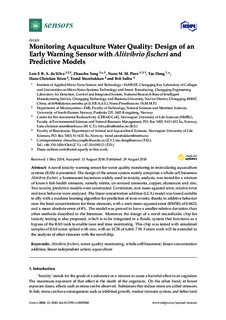| dc.contributor.author | da Silva, Luis Filipe B. A. | |
| dc.contributor.author | Yang, Zhaochu | |
| dc.contributor.author | Matos Pires, Nuno Miguel | |
| dc.contributor.author | Dong, Tao | |
| dc.contributor.author | Teien, Hans-Christian | |
| dc.contributor.author | Storebakken, Trond | |
| dc.contributor.author | Salbu, Brit | |
| dc.date.accessioned | 2019-03-15T07:38:33Z | |
| dc.date.available | 2019-03-15T07:38:33Z | |
| dc.date.created | 2018-10-13T12:12:00Z | |
| dc.date.issued | 2018 | |
| dc.identifier.citation | Sensors. 2018, 18 (9), 1-16. | nb_NO |
| dc.identifier.issn | 1424-8220 | |
| dc.identifier.uri | http://hdl.handle.net/11250/2590131 | |
| dc.description | This article is an open access article distributed under the terms and conditions of the Creative Commons Attribution (CC BY) license | nb_NO |
| dc.description.abstract | A novel toxicity-warning sensor for water quality monitoring in recirculating aquaculture systems (RAS) is presented. The design of the sensor system mainly comprises a whole-cell biosensor. Aliivibrio fischeri, a luminescent bacterium widely used in toxicity analysis, was tested for a mixture of known fish-health stressors, namely nitrite, un-ionized ammonia, copper, aluminum and zinc. Two toxicity predictive models were constructed. Correlation, root mean squared error, relative error and toxic behavior were analyzed. The linear concentration addition (LCA) model was found suitable to ally with a machine learning algorithm for prediction of toxic events, thanks to additive behavior near the limit concentrations for these stressors, with a root-mean-squared error (RMSE) of 0.0623, and a mean absolute error of 4%. The model was proved to have a smaller relative deviation than other methods described in the literature. Moreover, the design of a novel microfluidic chip for toxicity testing is also proposed, which is to be integrated in a fluidic system that functions as a bypass of the RAS tank to enable near-real time monitoring. This chip was tested with simulated samples of RAS water spiked with zinc, with an EC50 of 6,46E-7 M. Future work will be extended to the analysis of other stressors with the novel chip | nb_NO |
| dc.language.iso | eng | nb_NO |
| dc.rights | Navngivelse 4.0 Internasjonal | * |
| dc.rights.uri | http://creativecommons.org/licenses/by/4.0/deed.no | * |
| dc.title | Monitoring aquaculture water quality: Design of an early warning sensor with Aliivibrio fischeri and predictive models | nb_NO |
| dc.title.alternative | Monitoring aquaculture water quality: Design of an early warning sensor with Aliivibrio fischeri and predictive models | nb_NO |
| dc.type | Journal article | nb_NO |
| dc.type | Peer reviewed | nb_NO |
| dc.description.version | publishedVersion | nb_NO |
| dc.rights.holder | © 2018 by the authors. Licensee MDPI, Basel, Switzerland. | nb_NO |
| dc.source.pagenumber | 1-16 | nb_NO |
| dc.source.volume | 18 | nb_NO |
| dc.source.journal | Sensors | nb_NO |
| dc.source.issue | 9 | nb_NO |
| dc.identifier.doi | 10.3390/s18092848 | |
| dc.identifier.cristin | 1620154 | |
| dc.relation.project | Regionale forskningsfond Hovedstaden: 273869 | nb_NO |
| dc.relation.project | Regionale forskningsfond Oslofjordfondet: 272037 | nb_NO |
| dc.relation.project | Internasjonale institusjoner: National Natural Science Foundation of China - 61650410655 | nb_NO |
| dc.relation.project | Norges forskningsråd: 276650 | nb_NO |
| dc.relation.project | Norges forskningsråd: 268017 | nb_NO |
| cristin.unitcode | 222,58,4,0 | |
| cristin.unitname | Institutt for mikrosystemer | |
| cristin.ispublished | true | |
| cristin.fulltext | original | |
| cristin.qualitycode | 1 | |

